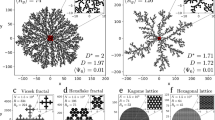Abstract
Mandelbrot1 has argued that a wide range of natural objects and phenomena are fractals; examples of fractal trees include actual trees, plants such as a cauliflower, river systems and the cardiovascular system. Here we apply the renormalization group approach2 to the collapse of fractal trees, which may be applicable to a variety of problems including cardiac arrest, failure of bronchial systems, failure of electrical distribution systems and the instability resulting in earthquakes.
This is a preview of subscription content, access via your institution
Access options
Subscribe to this journal
Receive 51 print issues and online access
$199.00 per year
only $3.90 per issue
Buy this article
- Purchase on Springer Link
- Instant access to full article PDF
Prices may be subject to local taxes which are calculated during checkout
Similar content being viewed by others
References
Mandelbrot, B. The Fractal Geometry of Nature (Freeman, San Francisco, 1982).
Wilson, K. G. & Kogut, J. Phys. Rep. C 12, 75–200 (1974).
Harlow, D. G. & Phoenix, S. L. Adv. Appl. Probability 14, 68–94 (1982).
Meyer, P. L. Introductory Probability and Statistical Applications (Addison-Wesley, Reading, 1970).
Smalley, R. F., Turcotte, D. L. & Solla, S. A. J. geophys. Res. (in the press).
Author information
Authors and Affiliations
Rights and permissions
About this article
Cite this article
Turcotte, D., Smalley, R. & Solla, S. Collapse of loaded fractal trees. Nature 313, 671–672 (1985). https://doi.org/10.1038/313671a0
Received:
Accepted:
Issue Date:
DOI: https://doi.org/10.1038/313671a0
This article is cited by
-
The fractal heart — embracing mathematics in the cardiology clinic
Nature Reviews Cardiology (2017)
-
25 Years of Self-organized Criticality: Numerical Detection Methods
Space Science Reviews (2016)
-
Modelling growth forms of the spongeHaliclona oculata (Porifera, Demospongiae) using fractal techniques
Marine Biology (1991)
-
Fractal dimension of fault systems in Japan: Fractal structure in rock fracture geometry at various scales
Pure and Applied Geophysics PAGEOPH (1989)
-
Elasticity and mechanical breakdown of Kevlar 149 aramid fibres by a probabilistic approach
Journal of Materials Science Letters (1988)
Comments
By submitting a comment you agree to abide by our Terms and Community Guidelines. If you find something abusive or that does not comply with our terms or guidelines please flag it as inappropriate.



